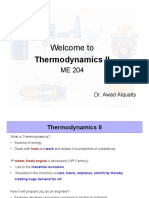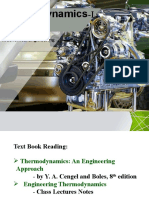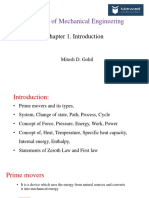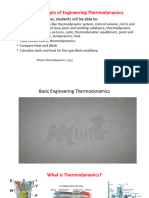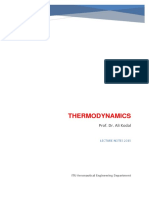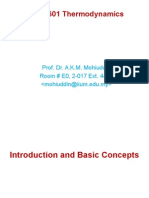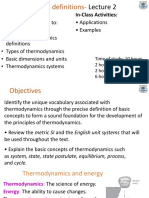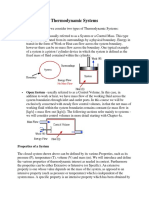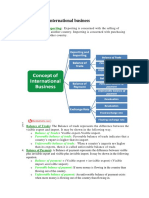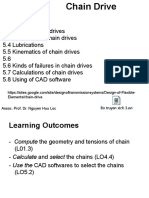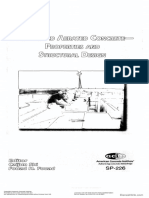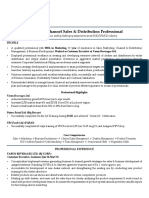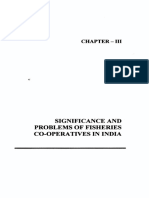1/7/2019
Engineering Thermodynamics
(MEE1003)
(3 credits)
by
Dr. T. Venugopal
Engineering Thermo Dynamics
Application of science or Heat Power
knowledge
Application of Engineering Thermodynamics
1
� 1/7/2019
Application of Engineering Thermodynamics
Application of Engineering Thermodynamics
2
� 1/7/2019
Application of Engineering Thermodynamics
Application of Engineering Thermodynamics
3
� 1/7/2019
Application of Engineering Thermodynamics
Application of Engineering Thermodynamics
4
� 1/7/2019
Application of Engineering Thermodynamics
Application of Engineering Thermodynamics
5
� 1/7/2019
Application of Engineering Thermodynamics
Application of Engineering Thermodynamics
6
� 1/7/2019
Approaches in Engineering Thermodynamics
Macroscopic or Classical Approach
Concerns with the gross or overall behaviour
No concern about molecular, atomic and subatomic levels
System behaviour is evaluated from observations of the overall system
It is a direct approach and involves less Mathematics
Applications:
Air compressors
Internal combustion engines
Refrigerators
Boilers
Air Conditioners
Air Compressor filling the air in a tank
7
� 1/7/2019
Approaches in Engineering Thermodynamics
Microscopic or Statistical Approach
Concerns with the structure on atomic and subatomic level
Characterise by statistical means
Average behaviour of the particles is used to relate the system’s
macroscopic behaviour
Applications:
• lasers
• plasmas
• fusion and fission
• high speed gas flows
• cryogenics
Nuclear Fission Reaction
8
� 1/7/2019
Thermodynamic System
A thermodynamic system is defined as a quantity of matter or a region
in space upon which attention is concentrated in the analysis of a
problem.
Everything external to the system is called the surroundings or the
environment.
The system is separated from the surroundings
by the system boundary. Boundary
Boundary is the contact surface between the
System
system and surroundings. Mathematically
boundary has zero thickness and thus it can
Surroundings
neither contain any mass nor any volume
in space
Classes of system- closed, open and isolated
Three classes of systems Boundary Energy out
• Closed system (fixed mass)
Closed
• Open system (fixed volume) System
• Isolated system
Energy in Surroundings
Closed system-fixed mass-no mass
No mass transfer
transfer across boundary-energy
may transfer into or out of the
system 2 kg
Eg: A certain quantity of fluid in a 2 kg 3 m3
1 m3
cylinder bounded by a piston, cooling
system of an automobile, a pressure
cooker while cooking, etc.
1/7/2019 18
9
� 1/7/2019
Classes of system- closed, open and isolated
Open system- mass transfer across Boundary
Energy out
boundary-energy may transfer into or Mass in
out of the system Open
Eg: An air compressor-air enters at System
low pressure and leaves at high
Energy in Surroundings Mass out
pressure, turbines, nozzles, water
Mass Control Mass
heater, water flow through pipes, etc. out surface in
V1 P1 V2 P2 A control volume (CV)
CV
- Fixed shape and size
Water
Water
- Heat and work interaction heater
heater
- Mass interaction
CV
1/7/2019 20
10
� 1/7/2019
Control Volume
Classes of system- closed, open and isolated
Isolated system-no interaction between system and surroundings-Fixed
mass-no energy and mass transfer across the boundary.
Eg: Thermo flask, house with walls insulated, entire universe
Boundary
System
Surroundings
No mass or energy transfer
1/7/2019 22
11
� 1/7/2019
Properties of a system-state
Property-describes the physical characteristics of a system
Eg: pressure P, temperature T, volume V, and mass m, viscosity (),
thermal conductivity (k), modulus of elasticity (E), etc.
Properties-macroscopic in nature
When all the properties of a system have definite values, the system is
said to exist at a definite state.
P2 2
P1 1
V2 V1
V
1/7/2019 23
Properties of a system-process and cycle
Properties are the coordinates to b-c Process
Pc c
a-b-c Cycle
define the state of the system. ++
P + +
Any operation in which one or + +
+ +
more properties of a system Pa
+ + + + b
a
changes is called change of state.
Vc Vb
The series of states passed V
through during a change of state is called the path of the change of state.
When the path is completely specified, the change of state is called as a
process. Eg: constant pressure process, constant volume process.
A thermodynamic cycle is defined as a series of state changes such that the
final state is identical with the initial state.
1/7/2019 24
12
� 1/7/2019
Types of properties and system
Properties –two types
• Intensive property (independent of mass)
Eg: Pressure, temperature, density, etc.
• Extensive properties (dependent on mass)
Eg: Total volume, total momentum, total mass, energy, etc.
Phase-a quantity of matter is homogeneous throughout in chemical
composition and physical structure
Every substance can exist in any one of the three phases, viz. solid, liquid
and gas
System-two types
• Homogeneous-system consisting of one phase
• Heterogeneous-system consisting to more than one phase
1/7/2019 25
Thermodynamic equilibrium
A system is said to exist in thermodynamic equilibrium when no change in
macroscopic properties is registered, if the system is isolated from
surroundings.
Thermodynamic equilibrium *Conditions
• Mechanical equilibrium-absence of external force
• Chemical equilibrium-no chemical reaction
• Thermal equilibrium-a system exists in mechanical and chemical
equilibrium is separated from its surroundings by a diathermic wall
(allows heat to flow)-no spontaneous change in any property of the
system
Isolated system-reach thermodynamic equilibrium in course of time-can
never depart from it spontaneously. (Thermo-Flask)
1/7/2019 26
13
� 1/7/2019
Quasi-static process
A gas contained in a cylinder- Stops
at equilibrium state initial
Final state
properties p1, v1, t1. Weight (p2,v2)
on the piston balances the W Weight
upward force exerted by the Piston
gas.
Gas (p1, v1, t1)
If the weight is removed-
System boundary
unbalance force exist-piston
P1 1
moves up under gas pressure
until it hit by stops. P
System reaches final P2 2
equilibrium states p2, v2, t2
1/7/2019
V1 V2 27
V
Quasi-static process (contd..)
The single weight on the piston is Stops
made up of many very small pieces of
weights-removed one by one.
W Weight
At any instant of the upward travel of
Piston
the piston, if the gas system is isolated,
the departure of the state of the Gas (p1, v1, t1)
System
system from the thermodynamic boundary
equilibrium state will be infinitesimally 1 Equilibrium
x
small. states
x
P x
Locus of all the equilibrium points x Quasi-static
x process
passed through by the system is known x
x2
as a “quasi-static process”.
V
Infinite slowness is the characteristics feature of a quasi-static process
1/7/2019 28
14
� 1/7/2019
Macroscopic property-Pressure
Pressure is the normal force exerted by a system δA
against a unit area of the bounding surface.
Fn
δFn
𝑝 = 𝑙𝑖𝑚 System
δA →δA′ δA
Pressure ‘p’ at a point in a fluid in equilibrium is the
same in all directions.
Unit of pressure - pascal (Pa), which is the force of one newton acting on
an area of 1 m2. 1 Pa = 1 N/m2
Other units of pressure bar and standard atmosphere (atm).
1 bar = 105 Pa
1 atm = 101.325 kPa = 1.01325 bar. 1 bar is thus very close to 1 atm
760 mm of Hg = 1 bar = 1 atm
1/7/2019 29
Macroscopic property-Pressure (Contd..)
Most of the instruments indicate pressure relative to atmospheric
pressure. Pressure of the system is its pressure above zero, or relative to
perfect vacuum.
Pressure relative to atmosphere is called gauge pressure.
Pressure relative to a perfect vacuum is called absolute pressure
Absolute pressure = Gauge pressure + Atmospheric pressure
p > 1 atm
Positive gauge pressure
or vacuum
Absolute pressure above p = 1 atm
atmospheric
Negative gauge pressure
or vacuum
Local atmospheric
pressure p < 1 atm
Zero pressure Absolute pressure below
perfect vacuum atmospheric
p=0 30
1/7/2019
15
� 1/7/2019
Pressure measuring instruments
Patm
Bourdon tube Manometer
(gauge pressure)
Patm
Barometer
Manometer Evacuated
(vacuum)
Hg
1/7/2019 31
Work and Heat transfer
A closed system and its surroundings can interact in two ways
• By work transfer
Energy interactions
• By heat transfer
Work is one of the basic modes of energy transfer. The action of force on a
moving body is identified as work. A force is a means of transmitting an
effect from one body to other.
But a force itself never produces a physical effect except when coupled
with a motion and hence it is not a form of energy.
Work is done by a force as it acts upon a body moving in the direction of
the force.
The action of force through a distance (or torque through an angle) is
called mechanical work.
1/7/2019 32
16
� 1/7/2019
Work and Heat transfer (contd..)
In thermodynamics, work transfer is considered as occurring between the
system and the surroundings.
Work is said to be done by a system if the sole effect on the things external
to the system can be reduced to the raising of a weight.
Boundary Work out
Motor Pulley
(+)
System
+ -
Battery Work in Surroundings
Weight (-)
System boundary
When work is done by a system, it is arbitrarily taken to be positive and
when work is done on a system, it is taken to be negative.
1/7/2019 33
pdV-Work or Displacement work
Let us consider a thermodynamic system at
initial pressure p1 and volume v1. Piston is
the only boundary, which moves due to gas
Final state
pressure. (p2,v2)
Let the piston moves to a new position 2, Weight
which is also in thermodynamic equilibrium Piston
specified by pressure p2 and volume v2.
Gas (p1, v1)
Any intermediate point in the travel of the
piston , let the pressure be p and volume V.
this must also be in equilibrium state.
When the piston moves an infinitesimal distance ‘dl’ and if ‘a’ be the area of
the piston, the force acting on the piston
F=pa
1/7/2019 34
17
� 1/7/2019
pdV-Work or Displacement work (contd..)
Infinitesimal amount of work done by the gas on the piston
dW=Fdl=padl=pdV
Work done by the system when the piston moves from v1 to v2
𝑣2
W-2= 𝑣1
𝑝𝑑𝑉
The magnitude of the work done is given by 1 Equilibrium states
x
the area under the path 1-2.
x
P x
Piston moves infinitely slowly so that every Quasi-static
x
state passed through is an equilibrium state. x process
x
Path 1-2 must be quasi-static process. x2
The integration 𝑝𝑑𝑉 can be performed only
V
dV
on quasi-static path.
1/7/2019 35
pdV-Work or Displacement work
Constant pressure process 1 2 1
P1
𝑣2 P
𝑊1−2 = 𝑣1
𝑝𝑑𝑉 =𝑝(𝑉2 − 𝑉1 ) P
W1-2 P2 2
Constant volume process
V1 V2 V
𝑣2
𝑊1−2 = 𝑝𝑑𝑉 =0 V
𝑣1
Constant pressure Constant volume
Process in which pV=C process process
𝑣2 𝑝1 𝑉1
𝑊1−2 = 𝑝𝑑𝑉 pV=p1V1=C 𝑝= P1 1
𝑣1 𝑉
𝑣2
𝑊1−2 = 𝑝1 𝑉1 𝑣1
𝑑𝑉 /V pV=C
P (quasi-static
𝑉2 𝑝1 process)
= 𝑝1 𝑉1 ln = 𝑝1 𝑉1 ln W1-2
𝑉1 𝑝2 P2
2
1/7/2019 V1 V2 36
V
18
� 1/7/2019
pdV-Work or Displacement work (contd…)
Process in which pVn=C , where n is a constant
pV=p1V1n=p2V2n=C
𝑝1 𝑉1 𝑛
𝑝=
𝑉𝑛
𝑉 −𝑛+1 V2
𝑣2 𝑣2 1
𝑊1−2 = 𝑣1
𝑝𝑑𝑉 = 𝑝1 𝑉1 𝑛 ( )𝑑𝑉
𝑣1 𝑉𝑛
= 𝑝1 𝑉1 𝑛 −𝑛+1 V1
𝑝1 𝑉1
𝑛 _ _
= (V21-n - V11-n) = [𝑝2 𝑉2 𝑛 𝑉2 1 𝑛 - 𝑝1 𝑉1 𝑛 𝑉1 1 𝑛] / 1-n
1−𝑛
= [p1V1-p2V2] / n-1
Similarly, for a process in which pVɣ=C, where ɣ = cp/cv
𝑊1−2 = [p1V1-p2V2] / γ-1
1/7/2019 37
Problems on pdV work
1. A mass of 1.5 kg of air is compressed in a
quasistatic process from 0.1 Mpa to 0.7 Mpa
for which pv = constant. The initial density of
air is 1.16 kg/m3. Find the workdone by the
piston. (Answer: 251.62 kJ)
𝑽 𝒑
𝒑𝟏 𝑽𝟏 𝒍𝒏 𝑽𝟐 = 𝒑𝟏 𝑽𝟏 𝒍𝒏 𝒑𝟏
𝟏 𝟐
1/7/2019 38
19
� 1/7/2019
A mass of gas is compressed in a quasi-static process
from 80 kPa, 0.1 cub.m to 0.4 Mpa, 0.03 cub.m.
Assuming that the pressure and volume are related by
𝒑𝒗𝒏 = constant, find the workdone by the gas system.
(Answer = -11.83 kJ)
Hint : value of n=1.336 (take log both sides)
p1V1n=p2V2n
A mass of gas is compressed in from 1 bar, 30˚C, 0.1
cub.m to 0.03 cub.m. Find the workdone by the gas
system if compression process is
(a)Isothermal (b) adiabatic process with γ = 1.4
(c) 𝒑𝒗𝟏.𝟐𝟓 = constant,
W.D. =, 12.03 kJ, 14.04 kJ, 15.4 kJ,
P2, polytropic = 450 kPa, 539 kPa
20
� 1/7/2019
Path function and point function
It is possible to take system from state 1 to 2 by three process A, B or C.
Thermodynamic properties-for a given state-there is a definite value of
for each property-are point functions.
Change in a thermodynamic property of a system in a change of state is
independent of the path the system follows during the change of state
and depends only on the initial and final states of the system.
The differentials of a point functions are exact or perfect differentials.
The area under each curve-work done 1
P1
for each process-depends on the path
B
P
going from state 1 to 2- inexact or C
P2 A 2
imperfect differentials.
For a cyclic process, change in a property is
V1 V2
zero 𝒅𝑽 = 𝟎, 𝒅𝒑 = 𝟎, 𝒅𝑻 = 𝟎 V
1/7/2019 41
Work and Heat transfer
Heat is defined as the form of energy that is transferred across the
boundary by virtue of a temperature difference. S.I. unit of heat is joule.
Heat is a form of energy in transit (like work transfer). It is a boundary
phenomena, since it occurs only at the boundary of a system.
Modes of heat transfer
• Conduction-between two bodies in direct contact
• Convection-between a wall and a fluid system in motion
• Radiation –between two bodies separated by empty space or gas
Boundary Heat out (-)
Heat flow into the system is taken as
positive, and the heat flow out of a
System
system is taken as negative.
1/7/2019 Heat in (+) Surroundings 42
21
� 1/7/2019
Work and Heat transfer (contd..)
Heat transfer is a path function.
It is valid for a quasi-static process, and the work transfer involved is
represented by the area under the path on p-v diagram. Whenever there
is a difference in pressure, there will be displacement work.
The pressure difference is the cause and work transfer is the effect. The
work transfer is equal to the integral of the product of the intensive
property ‘p’ and the differential change in the extensive property ‘dV’.
Likewise, whenever there is a difference in temperature, there will be heat
flow. The temperature difference is the cause and heat transfer is the
effect.
The heat transfer can be written as the integral of the product of the
intensive property ‘T’ and the differential change of an extensive property,
say ‘X’.
1/7/2019 43
Free expansion with zero work transfer
The expansion of work against vacuum is called as free expansion
Gas Vacuum Gas
Partition
Gas Vacuum 1
P
1
2
P
2 V
1/7/2019 44
V
22
� 1/7/2019
Forms of Energy
Internal Kinetic Potential
Mechanical Heat Chemical Electrical
Thermodynamics M. D. Eastin
Forms of Energy
E= Total Energy
23
� 1/7/2019
Internal Energy
Internal Energy is the sum of
potential and kinetic energies
of molecules.
It is the energy due to
temperature.
Velocity and degree of activity
of molecule α Temperature
Mechanical Energy
Mechanical Energy is the form of energy that can be
converted to mechanical work completely and directly by an
ideal mechanical device like turbine.
Kinetic, potential and flow energies are the familiar forms of
mechanical energy.
24
� 1/7/2019
Energy Transfer by Heat
Heat is the form of energy that is transferred between two
systems (or a system and its surroundings) by virtue of a
temperature difference.
The 1st Law of Thermodynamics
Heating or stirring can raise
the Temperature of the water.
Joule’s apparatus
25
� 1/7/2019
The 1st Law of Thermodynamics
The First Law of Thermodynamics states that total energy is conserved for any
thermodynamic system
→ energy can not be created nor destroyed
→ energy can only change from one form to another
The 1st Law of for a closed system
Increase in internal energy = Heat added Work done
dU dQ dW
U Q W
dt dt dt
26
� 1/7/2019
The 1st Law of for a closed system
Problems on First law
1.A domestic refrigerator is loaded with food and
the door closed. During a certain period the
machine consumes 1 kW h of energy and the
internal energy of the system drops by 5000 kJ.
Find the net heat transfer for the system. (Hint:
1 W = 1 J/s & 1 kW = 1000 W)
Answer : -8600 kJ
27
� 1/7/2019
2. The heat transferred into a closed system
during a process is 3000 kJ. If the work done by
the system is 1600 kJ, determine the change in
total energy of the system.
(1400 kJ)
3. A system is composed of gas contained in a
cylinder fitted with a piston. The gas expands
from a state 1 for which E 1 = 70 kJ to a state
for which E 2 = -20 kJ. During the expansion,
the gas does 60 kJ of work on the
surroundings. Determine the amount of heat
transferred to or from the system during the
process.
(-30 kJ, heat transferred from the system)
28
� 1/7/2019
Problems on First law
4. A mixture of gases expands at constant
pressure from 1 MPa, 0.03 𝑚3 to 0.06 𝑚3
with 84 kJ positive heat transfer. There is
no work other than that done on a piston.
Find ΔE for the gaseous mixture.
(54 kJ)
Problems on First law
5. During a working stroke, an engine rejects
200 kJ/kg of heat of the working substance.
The internal energy of the working substance
also decreases by 350 kJ/kg. Determine the
work done by the engine.
(150 kJ/kg)
29












